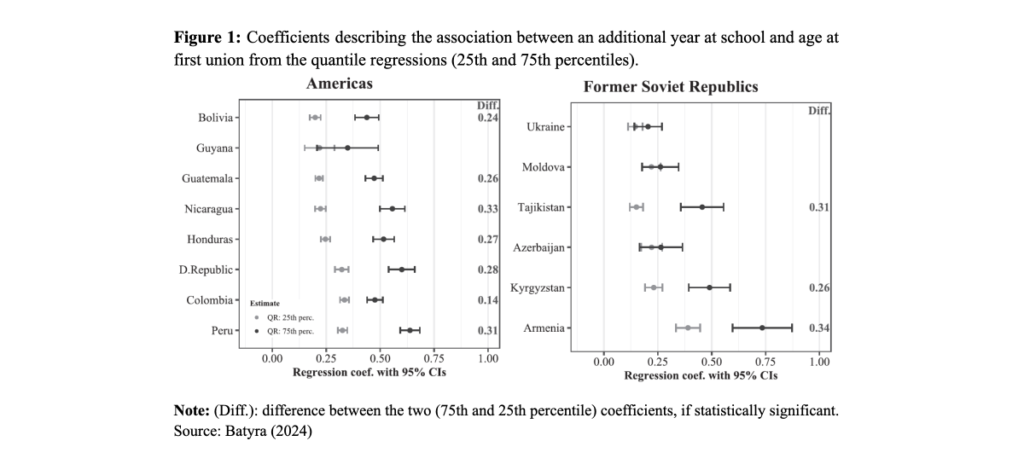Early union formation and motherhood are frequently observed in low- and middle-income countries, where heterogeneity in the timing of family formation is also high. Using Demographic and Health Surveys for 50 countries and quantile regression analysis, Ewa Batyra casts new light on the role of education in shaping these patterns and disparities.
The positive association between the level of women’s education and the age at which they start forming families is one of the most studied relationships in the discipline of demography. However, researchers have focused on examining this association at only one point of the distributions of age at first union and age at first birth. Existing studies ascertain how additional schooling shifts the mean of age at first union and first birth, or the proportion of women who experience these events by a given age (for example, first union before age 18). These approaches, however, ignore the variation in the association between education and the timing of family formation within populations.
In a recently published paper, I take a different approach and use quantile regression analysis to study heterogeneity in the link between additional schooling and age at first union and first birth across the distributions of these events in 50 low- and middle-income countries (Batyra 2024). In other words, I study whether the effect of additional schooling on relatively early union formation and childbearing (i.e., the left parts of the distributions of these two events) is similar or different to its effect on other parts of the distributions, those that correspond to later ages.
Links between additional schooling and timing of family formation: differences by quantiles
I took a cross-country perspective and focused on 50 nations in Africa, the Americas, Asia and the former Soviet Republics. I explored if an additional year at school is associated with postponement of family formation uniformly in the lower quantiles (i.e., where age at family formation is lower, thus early) and the upper quantiles (i.e., where age at family formation is higher, thus late). Figure 1 presents the results of the quantile regressions for the 25th and 75th percentiles for age at first union in two selected regions, namely the Americas and the former Soviet Republics. Where the confidence intervals for the two estimates do not overlap, the difference (marked as Diff.) between these two point estimates is noted.

All the coefficients are positive, indicating that completing more years of education delays first union formation, as expected. However, in many countries, the magnitude of the relationship varies across the distribution. Namely, an additional year of schooling raises the 75th percentile by more than it raises the 25th percentile. These findings highlight heterogeneity in how education is related to the timing of union formation, with the association being weaker in the lower than the upper parts of the age-at-first-union distribution. This pattern of heterogeneity is visible in almost all countries in the Americas as well as West Africa, the majority of countries in East and Central Africa and Asia, and half of the countries in the former Soviet Republics. Similar conclusions are reached when the link between years of schooling and age at first birth is considered.
Substantively, these results mean that additional schooling has a weaker effect on the reduction of early unions and births than on later ones. The existence of marked differences in the coefficients of the quantile regressions and a weaker association in the lower parts of the age at first union and first birth distributions also mean that there is a tendency for the dispersion of these distributions to grow with increasing years of schooling. In other words, education increases heterogeneity in the timing of family formation within countries.
Conclusions
Receiving more schooling does not translate into uniform changes in the timing of family formation for women in many low- and middle-income countries. These findings provide pointers for understanding the persistence of high levels of early marriage and pregnancy despite educational expansion, and the large disparities in age at first union and first birth. They are also relevant from a policy perspective, as they underline that, despite the generally positive association between additional schooling and age at family formation, expanded access to education may provide insufficient impetus for reducing early unions and childbearing. My findings are in line with the mounting evidence that many students in low- and middle-income countries receive poor-quality education and that disparities in educational quality are high within countries (Prichett 2013; Psaki et al. 2018). In such contexts, spending more time in school may not mean learning more, or enhancing labor market prospects. If schooling – one of the channels through which education influences family formation behavior – brings little in terms of learning and work opportunities for some women, then the way education is related to family formation is likely to vary across the population. The extent to which disparities in education quality drive the heterogeneous association between schooling and the timing of family formation requires further research. What emerges clearly, however, is the importance of considering the whole distributions of age at first union and first birth when studying the link between these events and education.
References
Batyra, E. (2024) The Relationship between Education and the Timing of Family Formation: Evidence from Quantile Regression Analysis of 50 Countries. Development and Change. Online First. https://onlinelibrary.wiley.com/doi/10.1111/dech.12846
Pritchett, L. (2013) The Rebirth of Education: Schooling Ain’t Learning. New York: Center for Global Development.
Psaki, S.R., K.J. McCarthy, and B.S. Mensch (2018) Measuring Gender Equality in Education: Lessons from Trends in 43 Countries. Population and Development Review 44(1): 117–42.


